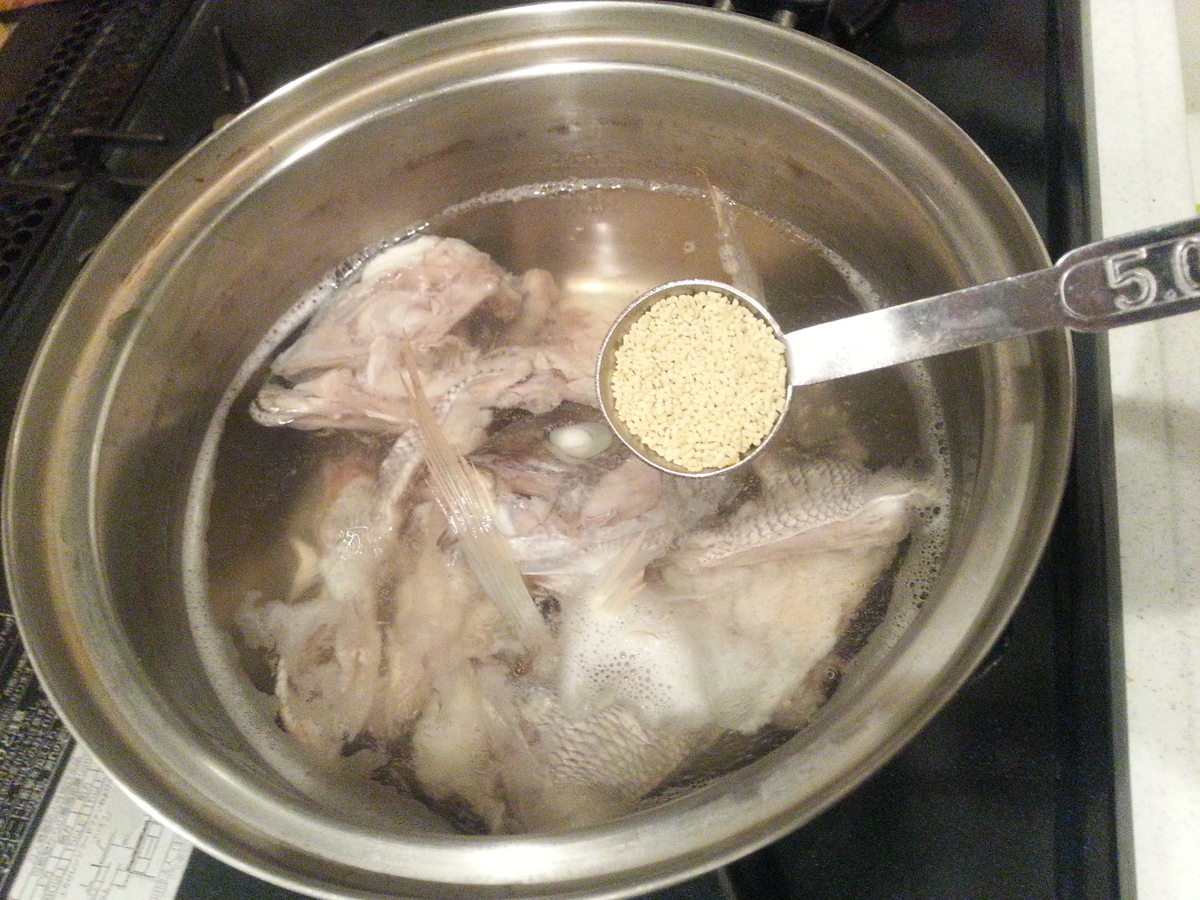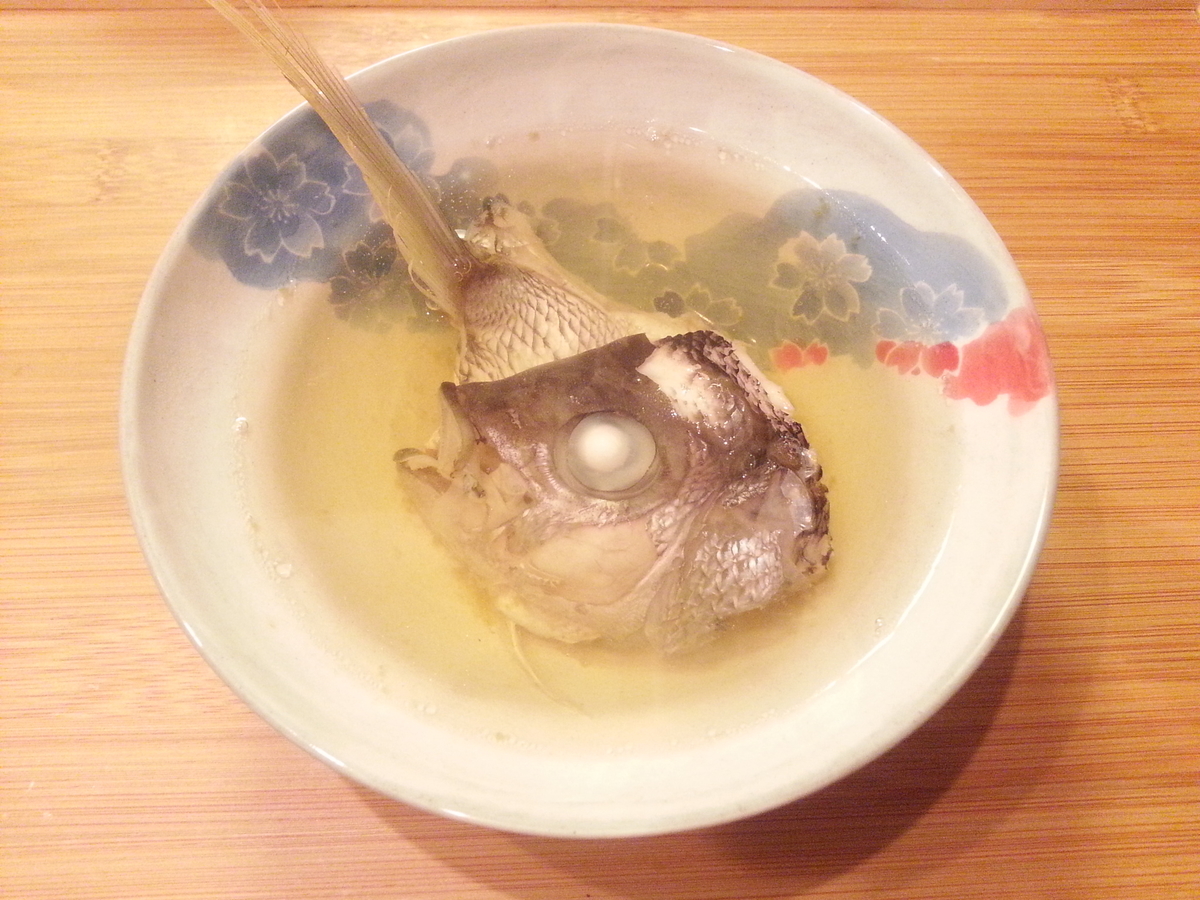In this article, I will show you how to make “Ushio-jiru (clear soup)” using fish head and bones. There are a few tricks to making tasty, clear and beautiful looking soup, so I will explain them as well.
“Ushio-jiru,” also known as clear broth, is a quintessential Japanese soup that embodies the essence of the sea. It is traditionally made using the “ara” or scraps of fish, which include the bones and head, to extract the maximum flavor from the seafood. The process begins by thoroughly cleaning the fish parts to ensure no bitterness remains, then gently simmering them in water, sometimes with the addition of kelp or seaweed to infuse the broth with a deeper oceanic taste.
The key to an authentic “Ushio-jiru” lies in its simplicity and the purity of its ingredients. Unlike other soups that may use a variety of seasonings, “Ushio-jiru” relies on the natural flavors of the fish and the sea. The result is a clear, light broth that is subtle yet complex in taste. It is often served with a slice of lemon or a sprinkle of green onions to enhance the fresh, clean flavor.
In Japanese cuisine, “Ushio-jiru” is not just a dish but a celebration of the ocean’s bounty. It is a testament to the Japanese culinary philosophy of “umami,” which is the savory taste that is considered the fifth basic taste alongside sweet, sour, bitter, and salty. This soup is a perfect example of how simple ingredients, when treated with respect and care, can create a dish that is both refined and deeply satisfying.
When presenting “Ushio-jiru” to those unfamiliar with Japanese cuisine, it is important to highlight its cultural significance and the meticulous preparation that goes into creating this seemingly straightforward soup. It is a dish that reflects the Japanese respect for nature and the art of maximizing flavor without waste. “Ushio-jiru” is more than just a soup; it is a culinary experience that offers a taste of the sea and a glimpse into the soul of Japanese cooking. It is a dish best enjoyed slowly, savoring each sip to appreciate the full depth of its flavor.
 ひなた
ひなたI’m trying to make a “Ushio-jiru”, but I just can’t get rid of the fishy smell. What should I do?
 じんた
じんたUse fresh bones as much as possible. The key points of cooking to remove the smell are “salt,” “hot water soaking,” “cleaning out debris,” and “removing scum”. I will explain them now.
 ひなた
ひなたThe soup I cooked got cloudy, any tips?
 じんた
じんたIf you boil the broth too hard, the flesh will get out of control and cause it to become cloudy. It is better to boil it gently.
 ひなた
ひなたI feel the flavor of the dashi broth is too weak, what should I do?
 じんた
じんたSome kinds of fish are difficult to make broth from. In such cases, don’t worry too much and use granulated dashi! The taste will be more complex and delicious.
 ひなた
ひなたThanks! That’s what I wanted to know.
If you make tiojiru at home, just by paying attention to the above points, you will be able to make it look and taste different. I also had trouble with this when I first became interested in fish dishes, but now I am able to make it well. I will introduce some tips from my experience.
Let’s get started.

“Ushio-jiru” Ingredients (4 servings)
- Fish ara (about 250 g)
- 1L water
- 10 cm square soup stock kelp
- Salt to taste
- granulated soup stock
- 2 tablespoons sake
- 1 tablespoon light soy sauce
- (as desired) mirin (sweet cooking sake)
If you are making this dish at home, you do not need to be particularly concerned about the ratio of fish bones to water. You can adjust the seasoning to taste as you finish, so there is no need to think too hard about it. To be frank, I’m prepared to use granulated dashi broth (^^♪
It is up to your taste, but in my case, my mother’s taste is to add mirin (sweet sake). Try adding just a tablespoon or two. It makes the soup slightly sweet. It is delicious.
Strictly speaking, “Ushio-jiru” is made with salt and sake as seasoning. However, it can be difficult to make at home, so I describe here a versatile way to make it.
“Ushio-jiru” Directions
The basic premise is that fish bones should be as fresh as possible.
- “Salting Process”: Sprinkle salt all over the fish and let sit for 20 to 30 minutes. It is better to use a colander at this time. If you use a tray, drippings from the fish will stick to the fish.
- “Hot water soaking process”: Dip the fish in boiling water for about 5 seconds, then remove from cold water.
- “Cleaning process”: Clean the scales, blood, and other debris from the fish in the water. Use bamboo skewers, toothpicks, or brushes to clean hard-to-reach areas.
- Put water, fish bones, soup stock kelp, and sake in a pot over medium heat. Just before the water comes to a boil, remove the dashi kombu.
- Once boiling, reduce the heat from low to medium and simmer for about 20 minutes.
- “Scum removal process”: Remove any scum that comes out in clusters during the process of 5.
- Add sake, light soy sauce, salt, granulated soup stock and mirin to taste.
How to make “Ushio-jiru” / Pictures and explanation
This time, I will use a head and bones of ao-dai (bluefin bream). Ao-dai itself is a relatively rare fish, but its bone is known to produce a good soup stock.

“Salting Process”. Sprinkle salt all over the fish in the colander. The salt is not only applied to the surface of the fish, but also to the entire fish. The osmotic pressure of the salt is expected to remove moisture and odor from the fish.

The reason for using a colander is to prevent fish drippings from reattaching to the meat. You can also place the colander on a bowl like this.

“Hot water soaking process”. Next, the bones are dipped in boiling water to remove any odor from the surface of the fish and to make it easier to clean. Dip the bones in boiling water for about 5 seconds, and when the surface turns white, remove from cold water. If there is a large amount of bone, divide it into several portions so that the bones do not stick to each other in the hot water. If the hot water does not cover all of the bones, the smell of the fish will not be removed.

Take it in cold water (it would not have to be ice water).

“Cleaning Process”. Cleaning is also a simple but important process. Remove scales from the face and other body surfaces. Please clean the back of the face well, as any remaining viscera, gills, or blood can cause a foul odor. It is a tedious process, but the watchword is, “Make it tasty, make it tasty, make it tasty.

There is a blood line running down the backbone, which is another source of odor, and should be removed with a brush or the tip of a toothpick.

So the cleaning is done and refreshed 🌟

Place fish bones, water, sake, and dashi kelp in a pot and begin heating from the water state. Medium heat.

Remove the kelp just before the water begins to boil. Leaving the kelp in place will cause it to become mushy and slimy.

Heat for an additional 20 minutes, bringing to a gentle boil. In our experience, 15 to 20 minutes of boiling time is sufficient. The key is to “boil gently” during this time. If the water is brought to a strong boil, the fish will fall apart and become cloudy.

“Scum removal process”: When a certain amount of lumpy scum comes out, remove it with a ladle. There are ladles on the market to remove scum that catch only bubbles, but this is not recommended for “Ushio-jiru”. If you remove only the foam, the odor will remain. I recommend the ladle without holes.

Approximately 20 minutes elapsed.

Tasting is a must in fish soup! You can’t get the right flavor with the right seasonings. Taste and adjust the seasoning as you go. If the flavor of the dashi broth is not enough, additional granulated dashi is a good idea!

In this case, 1 teaspoon of kombu-flavored granulated dashi.

1 tablespoon light soy sauce.

1 tablespoon of sake added.

When served in a bowl, the bluefin tidbits of “Ushio-jiru” is ready to eat. How do you like it? The soup is now clear with little cloudiness💛.

 じんた
じんたThere is no smell at all. The aroma of fish broth is very pleasant. Delicious!
It is also delicious with rice cakes.

=スポンサーリンク=
Summary
In this issue, I introduced how to make “Ushio-jiru” using fish head and bones. Because it is a delicate dish, the smell of fish is inevitably bothersome, but the key to preventing the smell is to preprocess the fish! If you can master the key points of pre-treatment such as “salt,” “hot water soaking,” “cleaning debris,” and “removing scum,” the taste will improve dramatically. I feel that the meaning of using fish bone is to take good care of the ingredients. Don’t throw it away, but make good use of it.


コメントお願いします(※は必須項目)